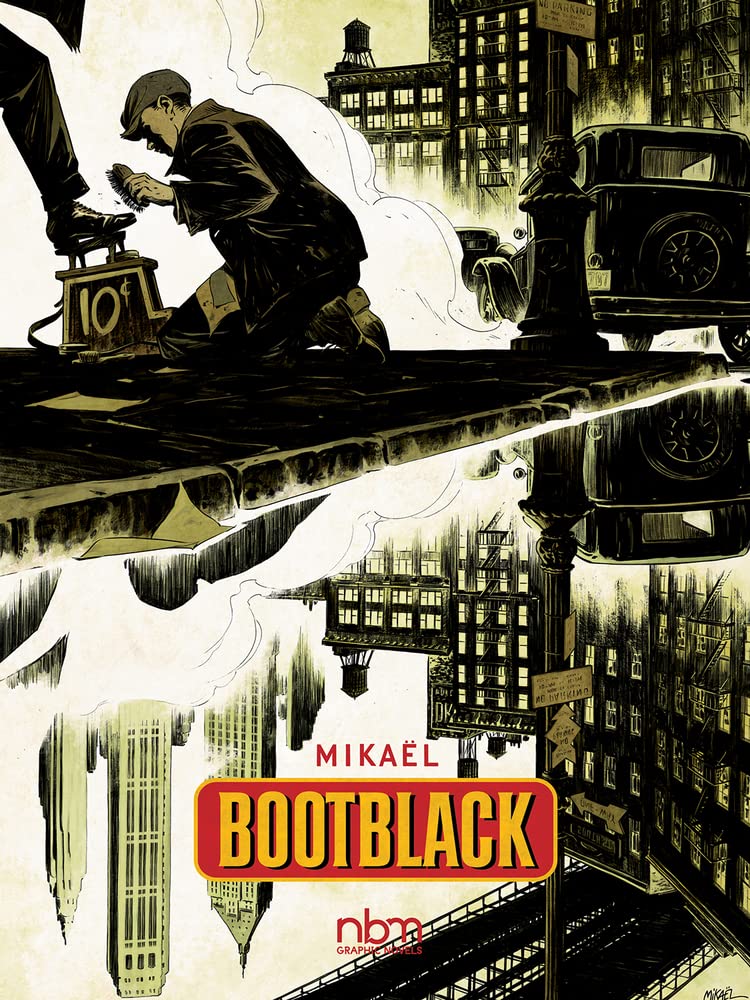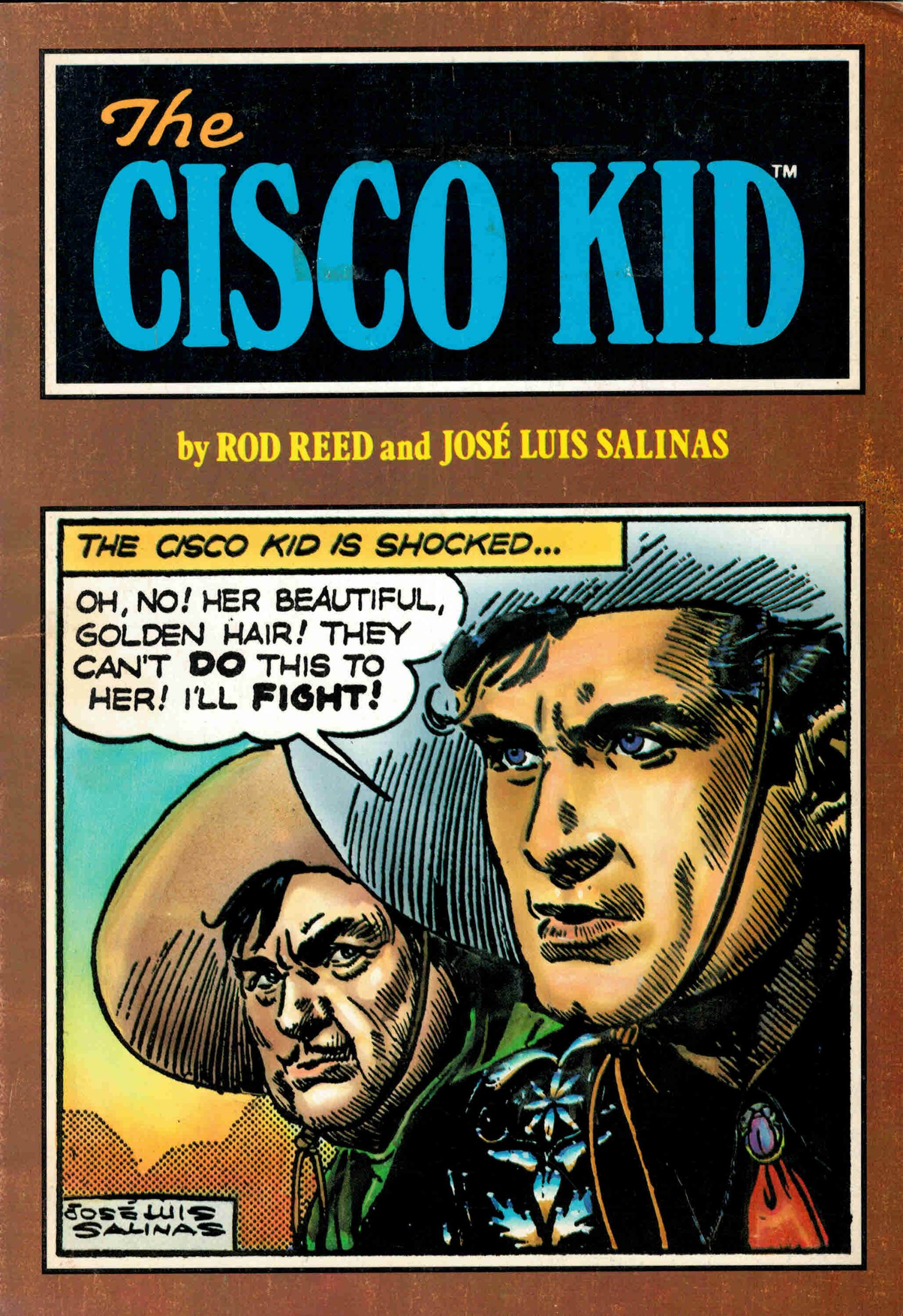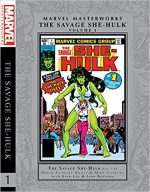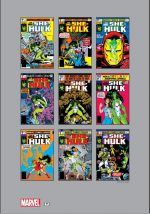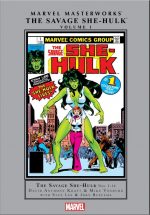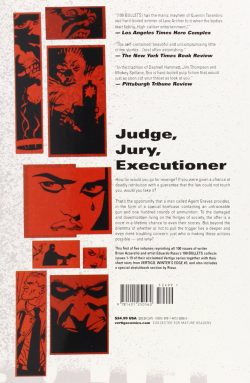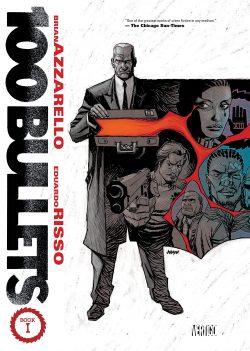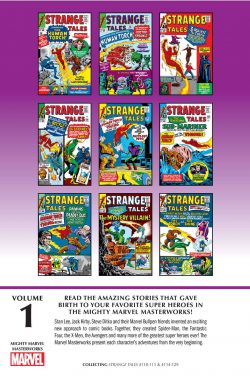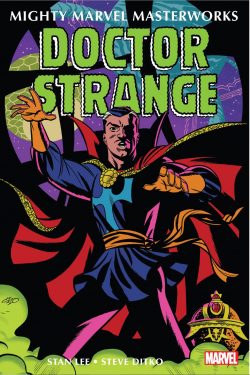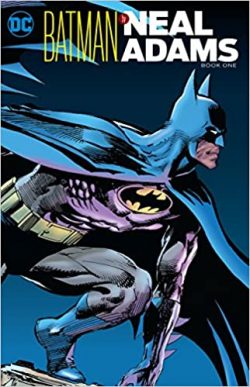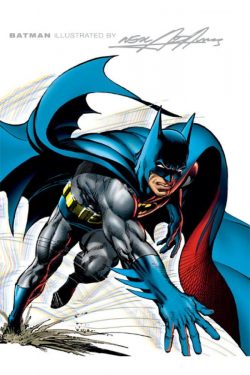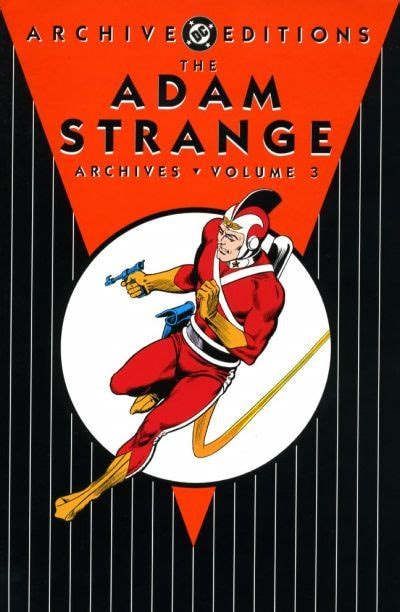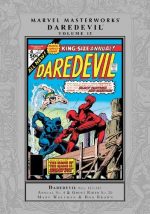

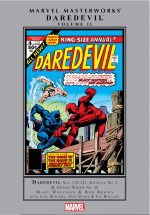
By Marv Wolfman, Bill Mantlo, Jim Shooter, Chris Claremont, Bob Brown, John Buscema, John Byrne, Sal Buscema, Gil Kane, George Tuska, Frank Robbins, Al Milgrom & various (MARVEL)Â
ISBN: 978-1-3029-1634-3 (HB/Digital edition)Â
Matt Murdock is a blind lawyer whose remaining senses hyper-compensate, making him an astonishing acrobat, formidable fighter and living lie-detector. A second-string hero for much of his early career, Daredevil was nonetheless a striking and popular one, due mostly to the captivatingly humanistic art of Gene Colan. DD fought gangsters, super-villains and even the occasional monster or alien invasion, quipping and wisecracking his way through life and life-threatening combat, utterly unlike the grim, moody, quasi-religious metaphor he became. Â
After a disastrous on-again, off-again relationship with his secretary Karen Page, Murdock took up with Russian émigré Natasha Romanoff, infamous and notorious ex-spy Black Widow. She was framed for murder and prosecuted by Matt’s best friend and law partner Foggy Nelson before the blind lawman cleared her. Leaving New York with her for the West Coast, Matt joined a prestigious San Francisco law firm but adventure, disaster and intrigue sought out the Sightless Sentinel and ultimately drew him back to the festering Big Apple…Â
Spanning May 1976 to May 1977, the 13th compilation re-presents Daredevil #133-143, Annual #4, a crossover from Ghost Rider #19-20, and a spin-off from Marvel Premiere #39-40, cover-dated December 1977 and January 1978. Â
We kick off with an Introduction from Marv Wolfman, recalling the strange days of his tenure as writer/editor before arguably the best proof possible of that opinion follows…Â
Marvel was always keenly aware that any real-world attention was beneficial. Daredevil #133 begins laying groundwork for an unfolding epic about fake news and disinformation in public office (and remember this set just after Watergate and long before Trumpism!) before digressing with a fanciful fluff piece co-starring real-world stage trickster and headline-seeker Uri Geller. Concocted by Wolfman, Bob Brown & Jim Mooney, ‘Introducing: Mind-Wave and his Fearsome Think Tank!’ is a happily forgettable yarn about a maniac in a super-tank attacking Manhattan. Thankfully, Mind-Wave‘s arch enemy (Geller, claiming to have psychic powers granted him by aliens) is there to aid the Scarlet Swashbuckler…Â
More sinister secrets of the perception-shaping masterplan of The Jester are revealed in #134’s ‘There’s Trouble In New York City…’ as disgruntled former football star/insurance salesman Brock Jones returns. Previously, he had stumbled into a plot to control Earth and took possession of a rocket-powered super-suit coveted by enemy agents. DD had almost been killed by the suit’s original owner, leading to the usual superhero misunderstanding and a savage clash. Now, as TV news showed Daredevil killing cops and with the shapeshifting Chameleon robbing at will, Brock again dons the suit to help the common man as The Torpedo, innocently adding to the chaos and confusion before the Chameleon is caught …Â
The Jester’s grand scheme is revealed in ‘What Is Happening?’ The Manic Mountebank has exploited a computer pioneer to create a wave of stories making the public mistrust the authorities by manipulating the media. (I’m not commenting, I’m not commenting…)Â
Seeing newspaper reports, photos and even news tapes of John and Robert Kennedy alive, superheroes killing cops and “proof†that Viet Nam never happened, but secret wars in Chile and Saudi Arabia did, much of the public readily accepts the villain was framed, resulting in DD being arrested and subsequently handed over to an army of thugs and gangsters.Â
John Buscema assumed pencilling with #136 as the Jester’s endgame is exposed. When President Gerald Ford announces that New York City’ s police and all its superheroes have gone insane, citizens are urged to defend themselves at all costs. The entire scheme has been devised to leave the city open to plunder by the Jester’s hastily-united army of mobsters…Â
Unable to keep away, DD takes action but is quickly captured and subjected to ‘A Hanging for a Hero!’ As a lynch mob of panicked citizens and enraged criminals almost execute the Man without Fear he flamboyantly escapes but is forced back into action for concluding episode 137 ‘The Murder Maze Strikes Twice!’ as “President Ford’s†broadcasts demand citizens take up arms and “take back Wall Street†from the thugs that now control it…Â
Deducing the Jester’s location, DD storms in, dismantles all the villain’s traps – and minions – and restores order and justice, only to discover personal crises boiling over…Â
Throughout the media reality war, Daredevil has been seeking to prove the innocence of Heather Glenn‘s father. Matt Murdock’s current girlfriend knows her dad isn’t a ruthless, murdering slumlord but that someone must have framed him. All evidence says otherwise.Â
Now, as Matt and Foggy return to the case, word comes (for readers, as two excerpted pages from Ghost Rider #19 – August 1976 by Tony Isabella, Frank Robbins & Vince Colletta) depicting Karen Page being kidnapped by friend and ally Stuntman…Â
It leads directly into Daredevil #138 where Wolfman, John Byrne & Mooney ask ‘Where is Karen Page?’ as the Man Without Fear drops everything for his one true love: heading for Los Angeles where Page is a Hollywood star with a complex convoluted life. However her relationship with hell-tainted Johnny Blaze is not why she was targeted, but rather from her father’s inventions and career as super-maniac Death’s Head …and the impostor now using the name to further his own insane plans…Â
The saga concludes in Ghost Rider #20 (Wolfman, Byrne & Don Perlin) as ‘Two Against Death!’ exposes who is truly pulling all the strings with Satan-spawn and Scarlet Swashbuckler pairing to save Karen. Meanwhile in Manhattan, Foggy continues investigating Glenn Industries and is shot…Â
The plot thread expands in Daredevil Annual #4’s ‘The Name of the Game is Death!’ Plotted by Wolfman, scripted by Chris Claremont, drawn by George Tuska and inked by Frank Chiaramonte, it finds The Black Panther aiding an industrialist whose son is abducted.Â
Thanks to friendship with King T’Challa and judicious use of Vibranium, Robert Mallory has built the world’s first Tidal Power Station. Someone thinks holding his son will win them the plans but hasn’t counted on T’Challa paying his friend a visit at this inopportune moment…Â
Daredevil, meanwhile, fights for his life, having stumbled into a furiously rampaging Sub-Mariner. Prince Namor has returned to the vile surface world because of a man named Mallory and a power station that while providing cheap clean energy for mankind will overheat the seas and divert the tides… Â
Concluding chapter ‘And Who Shall Save the Panther?’ begins with the Great Cat prowling Manhattan, having tracked the crime to ambitious mobster Ruffio Costa. Sadly, he is unable to defeat the gangsters alone and eventually DD steps in to deliver a ransom, accidentally brining Sub-Mariner along for the ride…Â
When the superbeings converge and clash, Costa is caught in the carnage and a lab explosion transforms him into something far worse that gradual climate crisis and the factions must all temporarily unite to defeat the threat of Mind-Master… Â
The editorial story behind Wolfman, Sal Buscema & Mooney’s ‘A Night in the Life’ (Daredevil #139) is a true insight to comics at their best, but for readers it’s simply a chance to enjoy enhanced drama, suspense and action as the search for a missing haemophiliac boy overlaps a police manhunt for a mad bomber demanding the return of his drug-addicted wife. Wolfman was unsurpassed at interleaving soap opera melodrama with costumed cavorting, and the fraught tone carried over to in #140 as Bill Mantlo, Sal B & Klaus Janson detailed ‘Death Times Two!’ when a runaway bus dumped Daredevil into a hunt for accidentally united old enemies The Gladiator and The Beetle who then aimed a runaway train at Grand Central Station and attempted to settle old scores with the hero amidst the dead and dying…Â
An even bigger change in tone began in #141. ‘Target: Death!’ was plotted by Wolfman, and scripted by Jim Shooter, with pencils divided between Gil Kane and Bob Brown, and Jim Mooney inking. It is very much a forerunner of what Roger McKenzie and Frank Miller would conceive of in months to come, opening with another murder attempt on Foggy and fresh insights into the abduction of his fiancée Debbie. More secrets of Glenn Industries are teased out, a killer dies and DD’s ultimate arch-nemesis returns for another killing spree before abruptly changing his mind and tying defeated Daredevil to a giant arrow and firing him at the New Jersey Palisades…Â
Pulling out all the stops for his final forays, Wolfman – with Brown & Mooney – resurrected more classic villains for #142. Escaping one doom, DD meets new hero Nova, even as Mr. Hyde and The Cobra reunite, targeting the Scarlet Swashbuckler as he passes the rooftop rainforest garden of a young millionaire – ‘The Concrete Jungle’… Â
This transitional selection concludes for now with ‘“Hyde and Go Seek†Sayeth the Cobra!’ (Wolfman, Brown & Keith Pollard) wherein the villains leave our hero to the carnivores populating the skyscraper Eden while they plunder the penthouse below. The goal is not wealth but ancient books and formulas to enhances their powers, but as ever, they grievously underestimate the boldness and ingenuity of the Man Without Fear…Â
Also included in my dynamic digital edition is the two-issue try-out tale starring hero/villain The Torpedo who first accidentally battled DD in Daredevil #126-127. After the brief reprise recounted above he was given his big shot at fame Marvel Premiere #39-40 (from December 1977-January 1978) before ultimately dying in Rom: Spaceknight and being replaced by a teenaged female. Â
‘Ride a Wild Rocket!’ and ‘…Battle with the Big Man!’ was a rushed-seeming collaboration of Wolfman, Mantlo, Brown, Al Milgrom, Josef Rubinstein, Bob Wiacek and Alan Weiss showing Brock hunting the rocketeer gang who originally owned his turbo-suit, but all his efforts to reclaim the acclaim of his quarterbacking days seem pointless. Harassed at home and bored at work, his American Dream is dying. Â
After almost triggering a nuclear meltdown he is considered a menace, even though he saved the state from atomic catastrophe, and a critical change comes after the hidden mastermind behind all his woes and superhero aspirations decides enough is enough. Â
As seen Captain America, Machine Man, and The Incredible Hulk, long-time villain Senator Eugene “Kligger†Stivak is a leader of criminal capitalists The Corporation and decides he will take care of Brock personally, but he has seriously underestimated the over-the-hill hero’s stubbornness and desperate need to regain his self-esteem…Â
Supplementing all the amazing comics adventures, the extras sections include Wolfman’s editorial from #133 detailing the circumstances of Geller/Marvel’s publicity stunt, followed by original art pages all inked by Jim Mooney, a cover and splash page from John Buscema plus a splash each for Byrne and Brown, and an extensive biography section. Â
As the social upheaval of the 1970s receded, these fabulous fantasy tales strongly indicated that the true potential of Daredevil was finally in reach. Their narrative energy and exuberant excitement are dashing delights no action fan will care to miss.Â
…And the next volume heads into darker shadows, the grimmest of territory and the breaking of many boundaries…Â
© 2019 MARVEL Â
